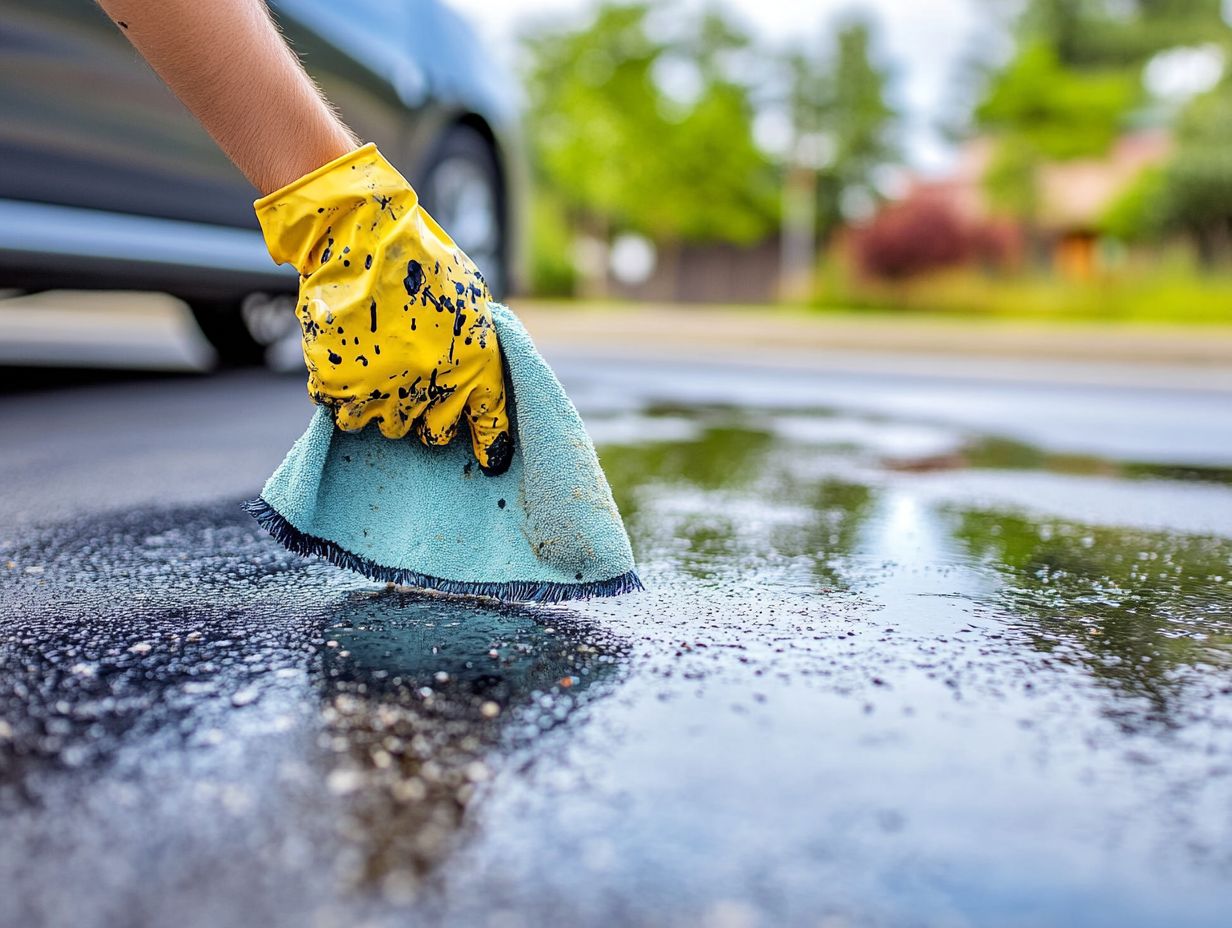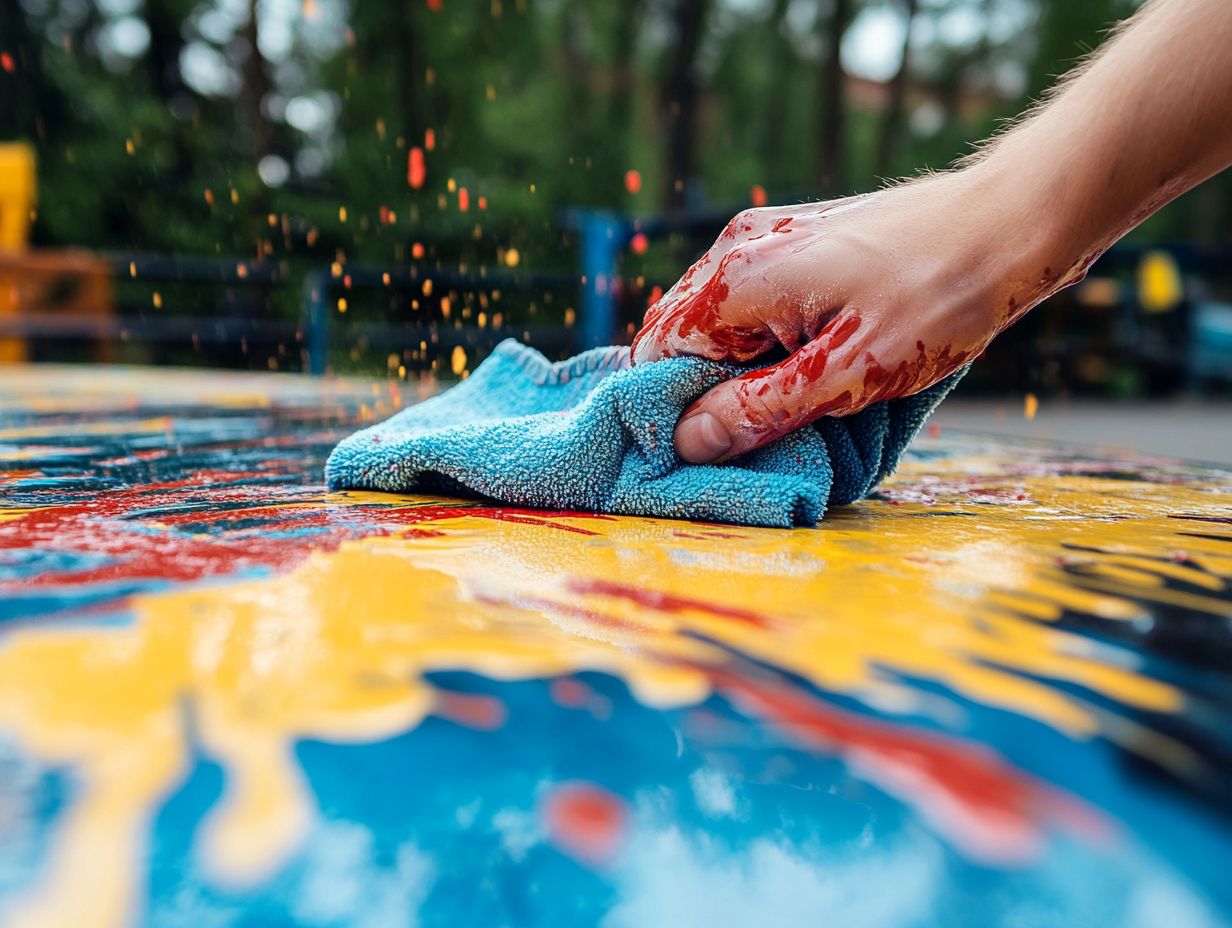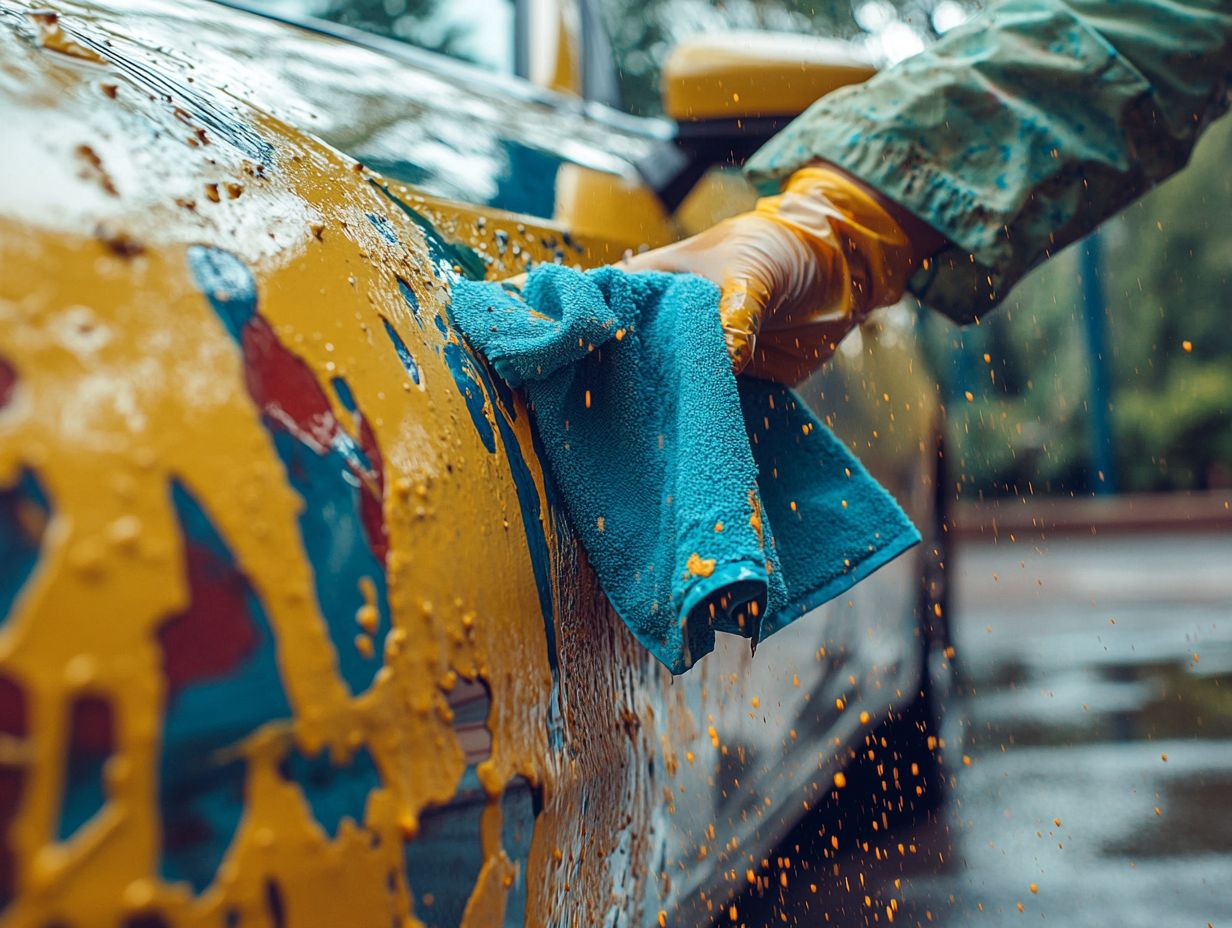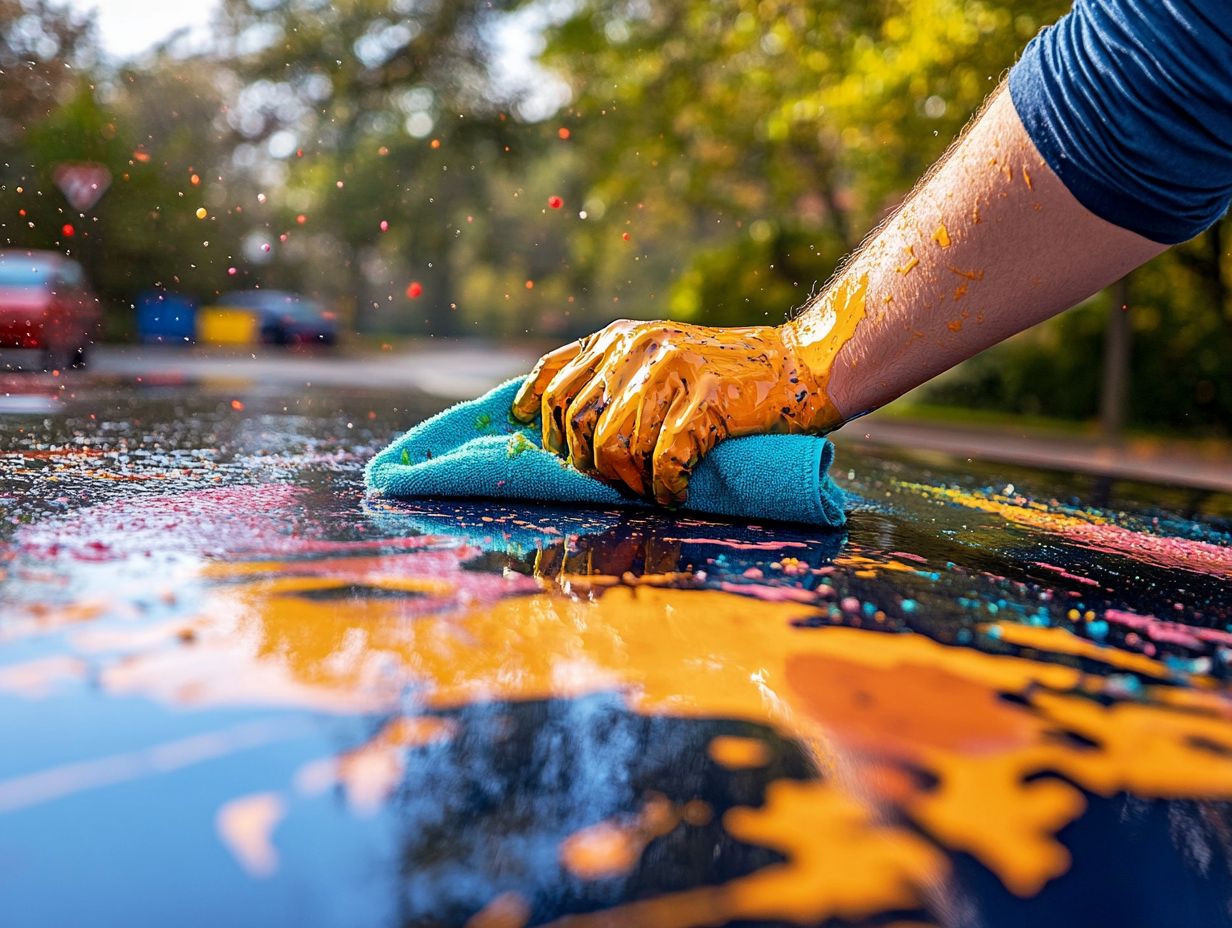How To Get Road Paint Off Your Car? 9 Steps to Follow
Accidentally getting road paint on my car can be super frustrating, but I’ve found some effective ways to tackle the problem.
This article dives into how road paint ends up on my vehicle, lays out a step-by-step guide for removing it, and shares some essential tips to prevent it from happening again.
It even compares chemical and non-chemical methods for anyone looking for alternatives. I can restore my car’s shine and protect it from future mishaps!
How Does Road Paint Get on Cars?

Road paint has a sneaky way of ending up on my car. Whether it’s driving a bit too close to freshly painted markings, parking near construction zones, or getting splattered by a passing vehicle, those unsightly stains can be a real headache to clean, especially if I let them sit. It’s super important for me to know how this happens so I can jump on it and restore my car’s look right away.
Plus, there’s the added fun of dealing with wet road paint during roadwork, especially during heavy traffic when quick maneuvers can be a must. There’s also a whole variety of road paint, from solvent-based to water-based formulas, each with its own set of challenges and potential for damage. The longer I leave that paint on, the more it can harden and bond with my car’s finish, which is definitely not what I want.
So, being aware of how this happens and acting fast can really help me avoid the nasty effects of road paint and keep my vehicle looking sharp.
Steps to Remove Road Paint
Removing road paint from my car isn’t just a quick scrub; it takes a bit of strategy to get it done right without messing up the paint underneath.
I’ll walk you through the essential steps and methods I use to safely get rid of that pesky road paint, all while keeping my vehicle’s exterior intact and bringing back its shine.
Gathering Materials
Before I jump into the paint removal process, I know it’s essential to gather all the necessary materials. Having everything on hand makes for a smoother and more effective cleaning operation.
I like to get a few cleaning agents ready—things like rubbing alcohol, vinegar, or even a dedicated paint thinner. I also make sure to have tools like a microfiber cloth, a paint scraper, and some safety gloves to keep myself protected during the whole process.
A soft-bristled brush is definitely a lifesaver for loosening stubborn paint spots without risking any scratches. Plus, I keep a bucket of warm water nearby for a thorough rinse afterward. In terms of safety gear, I always wear a dust mask to avoid inhaling any fumes, especially when I’m using chemical agents.
I can’t stress enough how important quality tools are. They help maintain the integrity of my car’s surface, preventing any unnecessary damage that might happen with cheaper options. By carefully selecting my materials, I ensure that the paint removal is not only effective but also helps preserve my vehicle’s finish for years to come.
Step-by-Step Guide
To effectively remove road paint, I’ve found that following a detailed step-by-step guide makes the whole process a lot easier and more efficient. I start by pre-washing the area with warm soapy water to loosen up any grime, and then I move on to the right cleaning agents to tackle the paint head-on.
Once I’ve got the surface prepped, I apply a suitable solvent or paint stripper with a clean cloth or sponge, making sure to cover those stubborn stains evenly. For the tougher spots, I grab a soft-bristled brush to help agitate the paint, which really makes removal simpler.
I always work in small sections so I can keep an eye on my progress. If the paint decides to play hard to get, I don’t hesitate to let the cleaning agent sit for a bit longer to give it time to do its magic.
Finally, I rinse the area with clean water and dry it thoroughly to avoid any streaks or scratches. It’s all about making sure the surface looks as good as new in the end!
Tips for Preventing Road Paint on Cars

I’ve found that taking proactive steps to keep road paint from sticking to my car can save me a lot of time and effort later on.
By using some protective measures and being aware of the areas where road paint is likely to splatter, I can keep my vehicle looking great and avoid the whole hassle of trying to remove paint later.
Protective Measures for Your Vehicle
Investing in protective measures for my vehicle is one of the smartest decisions I can make to keep it looking its best. I love regularly applying a quality wax or protective coating because it creates a barrier against road paint, making it much easier to clean off any accidental splatters.
These protective methods help fend off harsh elements like UV rays, dirt, and environmental contaminants that can really cause damage over time. By making waxing and coatings a regular part of my automotive care routine, I’m not just enhancing my car’s appearance; I’m also extending the lifespan of the paintwork.
Taking this proactive approach can save me a bundle in future cleaning and restoration efforts, making it a pretty cost-effective solution. Getting into the habit of regular application means I can enjoy a cleaner, well-maintained vehicle that stays in peak condition for years to come.
Alternative Methods for Removing Road Paint
If traditional methods aren’t cutting it for me, I find that exploring alternative ways to remove road paint can really change the game. There are so many options out there, from chemical solutions to eco-friendly choices.
It’s all about finding the right technique to tackle that stubborn paint residue without causing any damage to my car.
Chemical vs. Non-Chemical Options
When I’m looking to remove road paint, I know that choosing between chemical and non-chemical options can really make a difference in the outcome and safety of the process. Chemical solutions like tar removers and degreasers work wonders, but I often lean towards non-abrasive options like citrus-based cleaners and gel cleaners because they’re safer for delicate surfaces.
Each method has its ups and downs. Chemical options usually penetrate and dissolve hardened paint super quickly, which is great for tougher jobs. However, they might contain volatile organic compounds (VOCs) that could pose health risks and harm the environment.
On the flip side, non-chemical methods like using hot water pressure washers or steam cleaning can also do the trick without those harsh toxins, though they do take a bit more elbow grease and time.
Safety is a big deal for me; I always wear protective gear like gloves and masks when I’m handling chemicals, and I make sure there’s good ventilation. Plus, I always check the local regulations on how to dispose of materials used in paint removal to keep my environmental footprint as light as possible.
Frequently Asked Questions

What is the best way to remove road paint from my car?
The best way to remove road paint from your car is by following a step-by-step process which includes using the right materials and techniques.
What materials do I need to remove road paint from my car?
You will need a bucket, car wash soap, a microfiber cloth, rubbing alcohol, a razor blade, and a car polish or wax.
Step 1: Rinse off the car paint with water
Before starting the cleaning process, rinse off the car paint with water to remove any loose particles or debris.
Step 2: Wash the car with soap and water

Use a car wash soap and water to gently scrub the affected area. This will help loosen the paint and prevent any scratches.
Step 3: Use rubbing alcohol
Apply rubbing alcohol to a microfiber cloth and gently rub the affected area. This will help dissolve the paint and make it easier to remove.
Step 4: Repeat steps 2 and 3 if necessary
If the paint is still present, repeat steps 2 and 3 until the paint is completely removed.
Step 5: Use a razor blade
If the paint is stubborn, you can use a razor blade to carefully scrape off the remaining bits. Be sure to use a new blade to avoid any scratches.
Step 6: Apply car polish or wax
After removing the paint, use a car polish or wax to restore the shine and protect the car’s surface.
